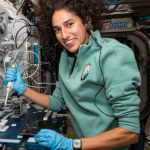About Exploration Medical Capability
The Exploration Medical Capability (ExMC) element of NASA’s Human Research Program (HRP) promotes human health and performance in space by advancing medical systems design and risk-informed decision-making for exploration beyond low-Earth orbit.

Human space travel poses health risks to current astronauts aboard the International Space Station and future astronauts on trips to the Moon, Mars, and beyond. To address these challenges, crewmembers need medical equipment that diagnoses and treats health issues triggered by the hazards of spaceflight. That’s why HRP developed the ExMC element.
ExMC determines and designs medical technologies that help maintain the health of astronauts on long-duration space missions. These technologies include data systems, monitoring devices, diagnostic capabilities, and treatment tools. ExMC researchers are tasked with ensuring these devices are inexpensive to build, require fewer resources to work, and are reliable in deep space.
Additionally, ExMC physicians and scientists develop models to determine the likelihood that a medical event will occur during a spaceflight mission. Personnel also define procedures for treating an ill or injured crewmember without access to an emergency room and with limited communications with ground-based personnel for assistance.
ExMC includes members at NASA’s Johnson Space Center in Houston, NASA’s Ames Research Center in Silicon Valley, California, Glenn Research Center in Cleveland, and Langley Research Center in Hampton, Virginia. The element also collaborates with the Translational Research Institute for Space Health (TRISH) and other research centers to assess and develop medical requirements for deep space missions.
Individual and team investigators interested in working with ExMC specifically and HRP in general can learn more at HRP’s collaboration portal.



























